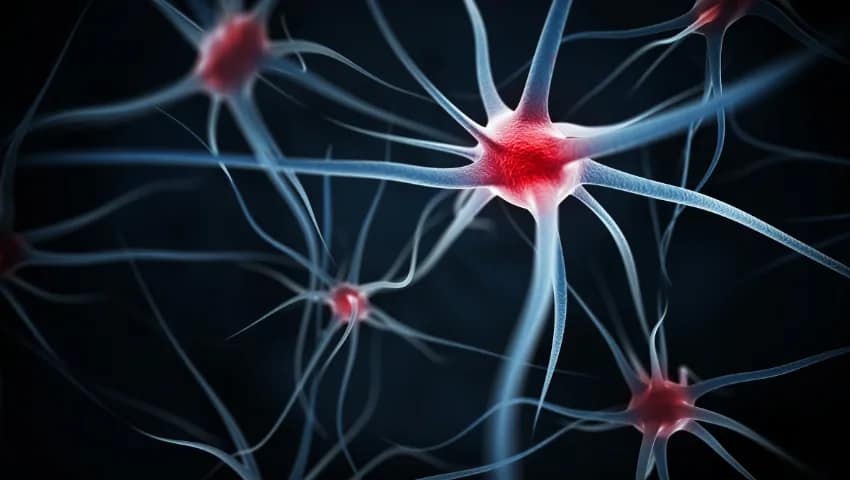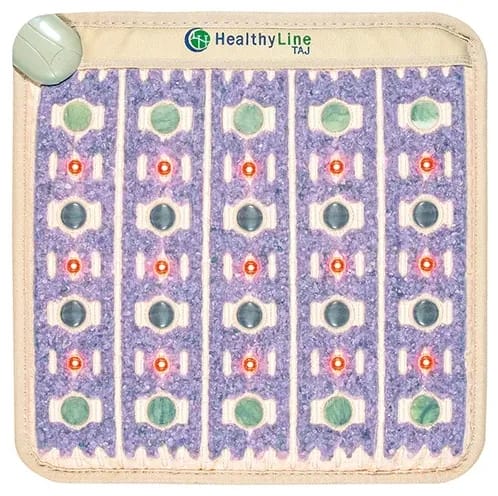I Tried PEMF For Stress & Anxiety: My 7-Day Experience

Hello and welcome to my 7-day experience of using PEMF for stress and anxiety.
I’m Marco Gentile. I’m a health coach and currently, I work at the Burke Williams Spa, Wellness & Fitness Center in Los Angeles.
Have you heard that an estimated 31% of U.S. adults experience anxiety disorders at some point in their lives?
To be honest, in the past few months, I have been struggling. My wife and I are expecting our second child, and I am getting very busy at work; this leaves me with very little time to focus on family and rest.

I was concerned that when the baby arrived, I would not be able to be present and have enough energy and stamina. I felt stressed and anxious, so I decided to give it a go!
In this article, I’ll walk you through my PEMF sessions, how I felt before and after, and whether I’d recommend it.
I’ll also show you the weekly therapy schedule I followed, which you can follow too. In the end, you’ll find my expert advice on the best PEMF devices you should get your hands on to deal with your stress and anxiety.
🔬The Science Behind PEMF for Stress & Anxiety Relief
With the rising interest in holistic wellness, PEMF (Pulsed Electromagnetic Field) therapy is gaining attention as a non-invasive way to promote relaxation and mental clarity. But does it work?
There’s real science backing PEMF therapy’s effects on stress and cognitive function. I’ll try to guide you through the scientific evidence supporting the use of PEMF for stress and anxiety. Please bear with me, I’ll make it easy to follow, I promise!
🧠 Increasing Blood Flow to the Brain

When blood flow to the brain improves, it brings more oxygen and nutrients to brain cells, supporting optimal function of areas like the prefrontal cortex (which handles decision-making and emotional regulation) and the amygdala (which is heavily involved in stress and fear responses).
A 2021 study published in Acta Neurochirurgica Supplement confirmed that PEMF can improve blood flow to the brain. Another 2024 study published in the National Library of Medicine found that PEMF therapy increased cerebral blood flow and oxygenation, which can help reduce brain fog and fatigue.
Stress hormones like cortisol can restrict blood vessels and limit circulation over time. By improving blood flow, you may help reverse this trend and ease physical symptoms like tension headaches, rapid heartbeat, or shallow breathing.
🧬 Energyzing the Body’s Cells
One of the biggest benefits of PEMF therapy is how it interacts with cellular health. Every cell in our body carries an electrical charge, and over time, factors like stress, poor sleep, and environmental toxins can deplete this energy.
Neurons (your brain cells) need optimal function to produce the right levels of neurotransmitters like serotonin, dopamine, and GABA — all of which play a direct role in mood and anxiety regulation.
Supporting cellular health means these brain chemicals can be produced and regulated more efficiently.
As shown by a 2023 article published in the International Journal of Molecular Sciences, electromagnetic pulses penetrate deep into tissues and cells, enhancing cellular function and health.
The article also suggests that PEMF can increase the production of ATP (Adenosine Triphosphate), which is the primary energy source for cellular processes.
This means cells can repair themselves faster, improving circulation and oxygen delivery, encouraging cells to function more efficiently.
When cells are functioning well, your parasympathetic nervous system (the “rest and digest” mode) can kick in more easily after a stressor. That means you’re not stuck in fight-or-flight mode as long, and you’re able to bounce back quicker.
⚖️ Balancing the Nervous System

Many people dealing with chronic stress or anxiety have an overactive sympathetic nervous system (fight-or-flight mode), which can lead to constant tension, shallow breathing, and even insomnia.
A 2024 study, published in IEEE Sensors Journal and conducted using wearables PEMF devices, has shown that PEMF helps shift the body into a more parasympathetic state (rest-and-digest mode), promoting deep relaxation and improving sleep quality.
This shows that the nervous system responds to PEMF therapy in profound ways. It explains why many people report feeling calmer and more centered after regular PEMF sessions.
💥 PEMF Studies on PTSD and Trauma Recovery
A 2019 research study published in Frontiers in Neuroscience shows that PEMF therapy may help reduce symptoms of PTSD. Daily PEMF sessions over 14 days reduced fear responses and helped the brain recover from trauma, especially in the hippocampus, a region linked to memory and emotion.
Another clinical trial from 2021 found that people with PTSD who received PEMF therapy reported better sleep, less anxiety, and a greater sense of calm. Some even described feeling happier and more able to handle stress after treatment.
The studies report improvements in fear response, emotional regulation, and overall sense of well-being, making PEMF a promising, non-invasive option for those struggling with trauma-related symptoms.
Comparison with Other Techniques, Like Meditation and Breathwork – Infographic

Which One Is Right for You?
Choosing between PEMF therapy, meditation, and breathwork depends on personal preference and lifestyle. Using PEMF for meditation requires patience and practice, but its long-term benefits for mental clarity and emotional balance are well-documented.
Breathwork is fantastic for those who need instant stress relief and want an active, engaging practice.
PEMF therapy, however, is ideal for those who want a science-backed, passive approach to relaxation, whether due to physical limitations, difficulty focusing, or just wanting to enhance their relaxation routine.
For many of my clients, a combination of these techniques works best.
📅 PEMF For Stress And Anxiety: The Weekly Therapy Plan I Followed
This is the exact protocol I’ve refined over the years of working with my clients, and it’s the same one I followed during my 7-day trial. I highly recommend sticking to this plan because it takes all the guesswork out of the process.
Are you new to PEMF? Let me quickly define frequency and intensity:
-
Frequency, measured in Hertz (Hz), refers to the number of electromagnetic pulses delivered per second by a PEMF device. In simple terms, it determines how fast the pulses occur.
-
Intensity represents the strength of the electromagnetic field emitted by the PEMF device. Most devices use Gauss (G) and MicroTesla (µT) in their user manual and controllers or phone apps. So I have included both in the table.
The plan is designed to walk you through each step in a clear, straightforward way, ensuring you get maximum benefits without having to figure things out on your own.
PEMF for Stress and Anxiety: My Weekly Therapy Schedule
| Day | Frequency | Intensity | Duration | Time of Day | Notes |
|---|---|---|---|---|---|
| Monday | 10 Hz | 100 µT 1 G | 20 min | Morning or Evening | Focus on relaxation and mood improvement. |
| Tuesday | 7.8 Hz | 50 µT 0.5 G | 15 min | Evening | Supports deep relaxation and stress reduction. |
| Wednesday | Rest | – | – | – | Allow the body to integrate the effects of prior sessions. |
| Thursday | 14 Hz | 200 µT 2 G | 25 min | Morning | Enhances mental clarity and reduces anxiety. |
| Friday | 4 Hz | 100 µT 1 G | 20 min | Evening | Promotes calmness and prepares for restful sleep. |
| Saturday | Rest | – | – | – | Recovery day to prevent overstimulation. |
| Sunday | 10 Hz | 150 µT 1.5 G | 30 min | Afternoon | Focus on overall relaxation and resetting for the week ahead. |
Additional Information
-
Initial Cycle – Follow the weekly plan for 6-8 weeks to establish baseline improvements in stress and anxiety.
-
Maintenance – After the initial cycle, reduce sessions to 3-4 times per week based on individual response to therapy.
-
Track symptoms such as stress levels, sleep quality, and mood using a journal or app.
-
Adjust session duration or intensity if side effects like headaches or fatigue occur.
-
Consult a healthcare professional if symptoms persist or worsen.
Flexible Guidelines for Daily Routine Integration
Don’t worry if you’re not a fan of strict schedules!
Here’s another approach that bends and flows with your life rather than forcing you to rearrange everything. Rather than adding another complicated task to your to-do list, this PEMF therapy flexible plan simply becomes part of your natural daily rhythm. Consider it more as a set of helpful suggestions than rules set in stone.
- Frequency Selection:
- Use 7-10 Hz for relaxation and stress relief.
- Use 14 Hz for mental clarity.
- Use 4 Hz in the evening to promote sleep readiness.
- Intensity:
- Start with low intensities (50-100 µT / 0.5-1 G) and gradually increase up to 200 µT / 2 G if well tolerated.
- Session Timing:
- Morning sessions can help with mental clarity and a calm start to the day.
- Evening sessions are ideal for winding down and improving sleep quality.
- Duration:
- Begin with short sessions (10-15 minutes) and increase up to 30 minutes as needed.
- Rest Days:
- Include at least two rest days per week to allow the body to adapt.
- Combination with Lifestyle Practices:
- Pair PEMF therapy with deep breathing exercises, mindfulness meditation, or yoga.
- Maintain a balanced diet rich in magnesium, omega-3s, and antioxidants to support nervous system health.
Whether you prefer the go-with-the-flow approach or have a clear roadmap to follow, both of these methods make it super easy to weave PEMF therapy into your everyday life.
The beauty is that either way works wonderfully for tackling stress and anxiety, while still keeping safety in mind and helping you get the most out of your sessions.
📈 PEMF For Stress and Anxiety: My 7-Day Experience
For this journal, I used the HealthyLine TAJ mat, a very user-friendly mat that is not too expensive and easy to use. I lay on it and strictly followed the plan above for 7 days, tracking my progress and sensations.
To be honest, I am a fan of PEMF, and I have easy access to it because of my job, but I never really did it for so many days consecutively and paid attention to it with a goal in mind.
It is worth mentioning that I generally use PEMF for muscle recovery after gym workouts and to deal with my aching legs after a run. So nothing stress-related.
Day 1-2: First Impressions
So here we go, this is where the story begins!
The initial feelings were usual. The hum of the device was barely noticeable, but the sensation of the electromagnetic pulses under my body was pleasant. At first, it felt like a soft vibration, almost like a gentle massage. It wasn’t overwhelming, but noticeable. I could feel the energy, it was calming and almost hypnotic.
My sleep pattern was as usual, and my smartwatch confirmed that my sleep was on track with the past month.
Day 3-4: Noticing Subtle Shifts
By day 3 of using PEMF therapy regularly, I started to notice subtle shifts, nothing dramatic, but enough to make me feel like this was working.
One of the first things I noticed was that PEMF significantly improved my sleep quality. Before I started using PEMF, I often found it hard to switch off at night. My mind would race, making it difficult to unwind after a long day.
But by day 3, I began falling asleep faster and staying asleep longer. I wasn’t waking up in the middle of the night as much, and when I did wake up, I felt quite rested, a feeling I hadn’t experienced in a while.
In terms of mood, I could tell something was shifting. I wasn’t waking up feeling groggy or irritable, and even in the afternoon, when I usually hit a mid-day slump, I felt surprisingly energized.
On the energy front, this was where I noticed the most significant improvement. Typically, after a long day at work, I’d be wiped out. But by day 4, I felt like I had an extra burst of energy after my sessions.
Day 5-6: Deeper Relaxation or Placebo?
By day 5, I found myself asking a big question:
Is this real, or is my mind just convincing me it’s working?
I’ve read a lot about the placebo effect, and while I wanted to believe PEMF therapy was making a difference, I also wanted some objective proof. So, I decided to track my stress levels more measurably.
So I decided to pay closer attention to my heart rate variability (HRV) using my smartwatch. HRV is a great way to measure stress; when it’s higher, the body is more relaxed and resilient, and when it’s low, stress levels are usually elevated.
Before PEMF, my HRV readings were low. But during the week, they are steadily improving. Not dramatically, but enough to make me believe something was shifting in my nervous system.
Another thing I noticed was my breathing. Normally, when I’m anxious or stressed, I catch myself breathing shallowly, especially in front of my computer. But during and after PEMF sessions, my breaths felt deeper and more natural, almost like my body was unconsciously letting go of tension.
It was like my whole system had been recalibrated to a calmer state.
Could it just be the effects of better sleep kicking in? Maybe.
But when I looked at my data—lower heart rate, better breathing, improved HRV – I knew something was happening beyond just better sleep and wishful thinking.
Whether it was or not a placebo, one thing was certain: I felt better, and that was all the proof I needed.
Day 7: Final Thoughts
After one full week of PEMF therapy, I can confidently say I’m a believer.
When I started this, I knew what PEMF Therapy was all about, but doing a deep dive for 7 days allowed me to set up some goals and understand the long-term benefits.
The biggest change? A deeper sense of calm.
It’s not that my stress disappeared, but my stress reaction felt different, more measured, and less overwhelming. Things that would normally spike my anxiety (like a long to-do list or unexpected work issues) didn’t hit as hard.
Sleep also improved noticeably. I woke up feeling more refreshed, and my smartwatch data backed it up. My deep sleep duration increased by about 15% compared to my usual weekly average.
Will sleep duration stay like that even when the baby cries at night?!?
Verdict: Should I Continue Using it?
Absolutely. For me, PEMF therapy is worth it, but it’s not a magic bullet. It works best as one piece of a larger stress-management toolkit, alongside things like proper sleep, mindfulness, and movement.
Bottom line? This week proved to me that PEMF therapy has real benefits, not just in theory but in actual daily life. And that’s enough reason for me to keep going.
If you’re willing to invest the time in learning how to use it effectively, the benefits can be significant.
But then, what device should I get my hands on?
Keep reading!
PEMF for Stress and Anxiety: Choosing the Right Device
When it comes to stress and anxiety, you’ve got plenty of options. You can choose a full-body PEMF device for a general calming effect, or go with something more targeted, especially around the head area, which is where PEMF can make a big difference in reducing mental tension and restoring balance.
1. PEMF Mats

PEMF mats are always a great choice. You can lie on them, sleep on them, put them under your mattress, or do yoga on them. Other than relieving your stress, they allow you to use PEMF to treat osteoporosis and other conditions that affect your entire body.
The catch? PEMF mats usually come with a higher price tag compared to smaller, targeted devices, and they’re not exactly travel-friendly. Since most need to stay plugged in, they’re best for home setups.
That said, if you want a simple, full-body treatment you can do at home, a PEMF mat could be well worth the investment.
Looking for the perfect PEMF mat? I’ve reviewed 26 of the best PEMF mats of 2025—and trust me, your ideal match is likely in there. Here are the top 3 that really impressed me:

HealthyLine JET

OMI PEMF Beyond

Therasage TheraPro
2. PEMF Pads

Pads can be a good option. You can rest your head on them or put them under your pillow when you sleep. Since many models offer battery power for true portability, they are easy to pack in a bag or take to work.
The main limitation? You’re only treating one area at a time. So you won’t be able to relax your entire body on them like on full-body mats. But delivering PEMF treatment to your head might be enough in most cases. Also, they are very good at doing PEMF for plantar fasciitis and other localized conditions.
Is a PEMF pad the solution for you? Then just check my article on the best PEMF pads. It will help you to find the one that suits your needs the best.
Here are the 3 PEMF pads that I consider to be the best to use for stress and anxiety:

HealthyLine TAJ Pad

OmniPEMF NeoRhythm

HealthyLine TAO Matrix
3. PEMF Chair Mats

Chair mats are one of my favorite tools for managing stress. What makes them stand out is their ability to help you relax while you’re actually experiencing stress, like during work. Instead of waiting until the end of the day, you can start easing tension right at your desk.
Like full-size mats, chair versions tend to be on the pricier side and need to be plugged in. They’re also one of my top picks for treating back pain with PEMF. That’s because sitting often makes the pain worse, and with a chair mat, you can target the discomfort right as it’s happening, without needing to stop what you’re doing.
If you think that a chair mat can be the best solution for your needs, just check out my guide to the 7 best PEMF chair mats! I’m sure you’ll find the right one for you!
Here are my top 3 chair mats to use for stress and anxiety relief:

HealthyLine JET Chair

HealthyLine Rainbow Chakra Chair

Grooni Earthing PEMF Infrared Mat Pro
4. PEMF Pillows

PEMF pillows are similar to pads when it comes to stress and anxiety treatment. You can rest your head on them or just use them to sleep. In both cases, you are delivering PEMF therapy where it’s most needed.
Other than for sleeping, which is their main purpose, they have relaxation-focused preset programs that you can use for your stress and anxiety.
They are also very versatile and portable. You can use them in many ways. You can rest your legs on it and use PEMF therapy for your arthritic knee, for instance. Also, they are quite affordable.
If you think a PEMF pillow could be a good option for you, please check my guide on the best PEMF pillows. Below are the 2 pillows that are most suitable to help with stress:

Sedona TimmyZZZ

OmniPEMF NeoRhythm Tube
5. PEMF Portable Devices & Wearables

PEMF wearables deliver targeted therapy right where you need it most. They’re compact, battery-operated, and built to support you on the go, so you can keep up with your routine while getting the relief you need.
The OmniPEMF NeoRhythm can be placed right on your head. It’s a great PEMF device for bone healing, but it also features a few specific preset programs to deal with stress and anxiety.
Most other wearable PEMF devices aren’t suited to help with stress, due to their specific shape and scope (with a notable exception – the Haelo, which is very expensive though)
Below are the 2 wearable devices I consider viable to help with stress:

OmniPEMF NeoRhythm

Haelo Symphony One
6. PEMF Face Masks
While their main goal is to deliver PEMF therapy to your face, the face masks can also be used to deal with stress. Well, at least the Sedona Mask certainly can.
Placing the mask on your face generates a sense of deep relaxation. Which is exactly what we are looking for.

Sedona Face Mask
FAQs
Some people feel immediate relaxation, while others need consistent use over days or weeks to notice significant changes.
While PEMF therapy is generally safe, it’s important to remember that, like any treatment, it can have rare side effects and some contraindications. If you have concerns or specific health conditions, we’ve covered everything in detail in a dedicated article. Be sure to check it out if you’re in doubt!
Scientific Evidence

ABOUT THE AUTHOR
Marco Gentile
Marco Gentile (CHC, CMT, CTP, CETS) is a seasoned wellness professional with over 10 years of experience helping clients achieve optimal health and longevity. Currently, he works at the Burke Williams Spa – Health, Wellness & Fitness Center in L.A., where he continues to inspire and support individuals on their wellness journeys.







